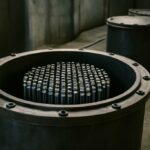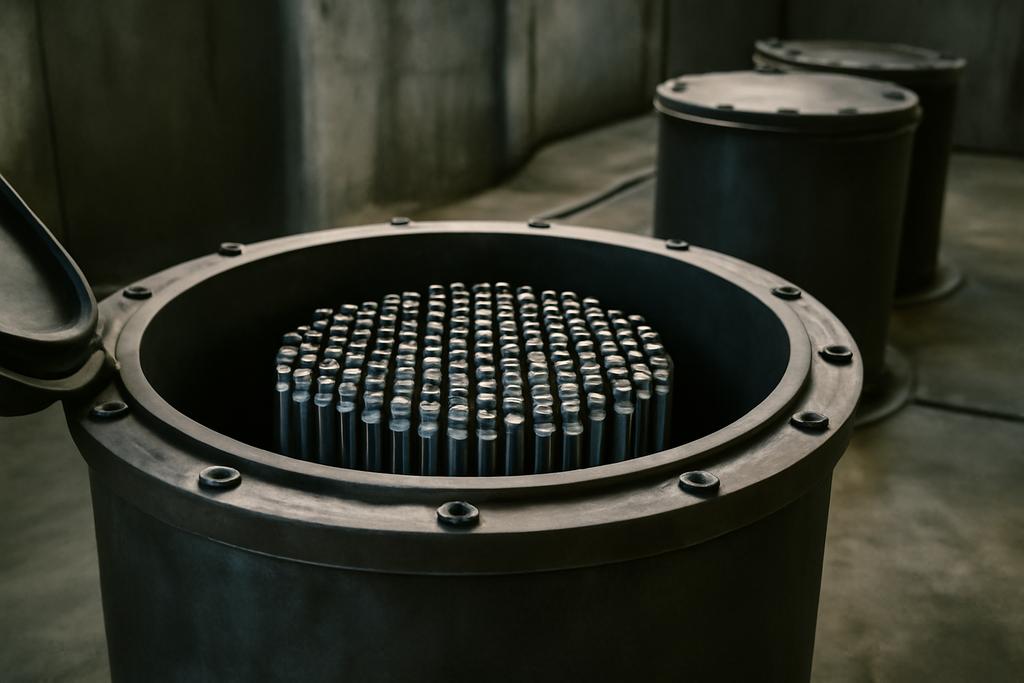In the story of nuclear safety, the math of how neutrons wander through matter sits like a backstage crew quietly ensuring the show never goes off-script. You can’t see them, but their decisions—whether a neutron is absorbed, scattered, or leaks away—determine whether a storage canister stays safely subcritical or drifts toward danger. As the world plans to generate more energy while storing ever more used fuel, scientists are racing to prove that the tools we rely on to model these invisible dances are up to the task. That’s the heart of a new study that pits an open-source hero against a long-standing industry standard, testing OpenMC against MCNP on a set of spent-fuel canister configurations inspired by the Swedish KBS-3 disposal concept.
The work comes from Chilean researchers working at the Centro de Investigación en Física Nuclear y Espectroscopía de Neutrones (CEFNEN) of the Comisión Chilena de Energía Nuclear, in collaboration with the Millennium Institute SAPHIR and Universidad Andrés Bello. The lead author is J. Romero-Barrientos, with coauthors J. Ruiz-Pineda, F. Molina, M. Zambra, and F. López-Usquiano. The goal isn’t merely academic ping-pong between codes; it’s about building trust in open, transparent tools as we design, test, and regulate complex waste-management systems. If MCNP is the old workhorse of criticality safety, OpenMC is the new open-science entrant trying to prove it can pull the same weight—grounded in the same physics and cross sections, but freely accessible to researchers and watchdogs alike.
Bridging Open-Source and Legacy Codes
At the core of the study is a straightforward question with outsized consequences: can OpenMC reproduce the criticality benchmarks that MCNP has stood up for years when you apply them to real-world SNF canisters? The team designed eleven configurations that vary in geometry, fuel state (spent versus fresh), and the environment around the canister—ranging from dry, air-filled tunnels to flooded rooms. The physics quantity they track is keff, the effective multiplication factor. If keff is below one, the system is subcritical and safe; if it creeps above one, the neutron population can grow and potentially escalate into a critical event. As a safety benchmark, keff is the metric that matters most, the numerical heartbeat of the problem.
The researchers built geometry and material definitions that echo real disposal concepts but kept them simplified enough to be transparent and reproducible. The canister design mirrors a popular disposal approach: a copper overpack encasing a cast-iron insert, with an inner array of PWR-like fuel assemblies, gaps filled with argon, and the surrounding environment tuned to reflect dry or flooded conditions. They used a 17 × 17 fuel-rod array, each rod modeled with a detailed radial scheme, and they populated the canister with inert gas inside while testing various outer environments. Cross sections came from ENDF/B-VIII.0, and the same cross-section library was used in both codes to isolate differences that aren’t physics but methodology. That alignment is crucial: the idea is to compare apples to apples, not apples to apples plus a different flavor of physics data.
To press OpenMC and MCNP into a fair fight, the team wrote equivalent inputs for both codes, kept identical materials, surfaces, and boundary conditions, and ran them with the same statistical discipline—50,000 particles per batch across thousands of batches. They even activated the same modeling nuance that MCNP uses by default: implicit capture. In other words, the comparison wasn’t about chasing tiny numerical tricks; it was about whether two fundamentally similar tools, one open-source and one proprietary, would tell the same story when the stakes are safety-critical.
Beyond the physics, the study also asks a meta-question about how we model the real world. Real SNF disposal sites are large, intricate, and vary from one country to the next. The authors test not only the core geometry and materials but also boundary choices that matter in practice: vacuum boundaries to mimic an open, leaky world; and periodic boundaries that emulate a lattice of canisters interacting with one another. The periodic option is especially interesting: it tests whether neutrons hop from one canister to its neighbor in ways that a single isolated-box model would miss. The results illuminate both the physics and the modeling choices we rely on when we claim safety.
Why It Matters for Waste Management
The stakes here are practical, not merely technical. The world’s appetite for uranium, and thus for stored spent fuel, is set to grow, with the International Atomic Energy Agency and other bodies emphasizing the need for safe, publicly acceptable long-term disposal strategies. The study lands in this context as a proof of concept: an open-source tool, OpenMC, can stand toe-to-toe with MCNP in the very domain that determines whether a disposal strategy remains safely subcritical under a range of credible conditions. That’s more than a validation exercise; it’s a statement about accessibility, transparency, and reproducibility in a field where those qualities are essential for public trust and regulatory scrutiny.
Another layer of significance is the democratization of safety analyses. MCNP has long been a workhorse in industry and academia, but access can be restricted by licensing. OpenMC, as an open-source platform, invites a broader community to scrutinize, validate, and improve models that govern how we handle highly radioactive material. The authors push this point by publishing their input decks, cross-section choices, and simulation settings on Zenodo, inviting independent replication and extension. That kind of openness isn’t just good science; it’s good governance, especially when distribution of responsibility and oversight matters as much as the physics itself.
On the technical front, the study underscores how closely an open tool can track a long-established reference when you align inputs and physics data. The eleven cases encompassed normal operation, flood scenarios, water leakage into the canister, and even a comparison of vacuum versus periodic boundaries to probe inter-canister coupling. Across all cases, the keff differences between OpenMC and MCNP stayed within fractions of a percent. In the no-leakage, large-geometry normal-operation cases, the difference hovered under 0.8 percent; in the flood scenarios, differences stayed under about 0.7–0.8 percent. In other words, OpenMC isn’t just broadly accurate—it’s consistently precise in the same ballpark as MCNP for these disposal-like configurations.
These results aren’t a guarantee for every conceivable future scenario, of course. The authors acknowledge that their fuel composition was a deliberately reduced, burnup-credentialed subset of nuclides, designed to keep the problem tractable while preserving the essential physics. They also caution that in some boundary conditions, mailing in a higher leakage scenario or adjusting the distance between canisters could shift the magnitude of coupling effects. Still, the central narrative is clear: when the physics are aligned, OpenMC behaves like MCNP enough to be trusted in preliminary safety analyses and in exploratory, open-science workflows that aim to expand validation into SNF transport and disposal domains.
Beyond the numeric results, the paper charts a path forward. The authors advocate expanding OpenMC’s validation envelope to real-world SNF transport and disposal cases, potentially incorporating more burnup credit and more diverse repository geometries. In a field where regulatory acceptance hinges on rigorous, reproducible methods, demonstrating that an open tool can stand up to a trusted benchmark is as consequential as the numbers themselves. It’s a signal that the toolkit of safety analysis can be both robust and accessible, a combination that could accelerate research, scrutiny, and, ultimately, public confidence in how we manage one of the defining legacies of the nuclear age.
What the Findings Change About Safety
One of the most tangible takeaways is the importance of how we frame the problem at the boundary. The study found that changing boundary conditions—vacuum versus periodic—produces measurable shifts in keff, illustrating how “the edges” of a model can influence the interior physics. In the most interactive scenario tested (argon inside the canister and air outside, a dry-storage-like setup), switching to periodic boundaries nudged keff upward by about 1.27 to 1.32 percent in OpenMC and MCNP alike. That isn’t nothing in a safety context; it quantifies how neighboring canisters could subtly modulate reactivity, a factor regulators might want to consider when evaluating lattice layouts and spacing in a repository portfolio.
Another striking fact is how small differences can be across mature codes, even in the face of complex, practical geometries. Across the eleven configurations, the authors report an overall trend: OpenMC’s keff values tend to be slightly lower than MCNP’s, but the discrepancies stay well within 1 percent in most cases. In the “normal operation” and “flood” families of scenarios, the maximum reported discrepancy hovered under 0.9 percent. In other words, the two tools agree so closely that the open-source option can be trusted to illuminate safety margins without inflating or hiding risk. That kind alignment matters when institutions are deciding which tools to invest in and which workflows to standardize for regulatory submissions.
There’s also a broader, almost philosophical, punchline: when you publish inputs openly and insist on principled benchmarking, you invite a culture of reproducibility that can outlive any particular software release. The authors’ explicit decision to share inputs, cross sections, and even exact simulation settings—tools that let anyone reproduce the study—embodies a practice that could become a norm in high-consequence modeling. If a repository’s safety depends on the fidelity of Monte Carlo simulations, then the more eyes on those simulations, the better the chances that the results will hold up under the long horizon of decades, if not centuries, over which spent fuel remains hazardous.
Finally, the findings hint at a practical, near-term implication: for researchers and regulators who want to explore a spectrum of design choices quickly and with transparent methods, OpenMC stands as a credible partner. The Chilean team’s conclusion—that OpenMC’s performance aligns closely with MCNP for SNF canister configurations and that the open tool could extend validation into SNF transport and disposal—reads as an invitation. It’s an invitation to a broader, more collaborative future in which safety analyses are not gated behind proprietary software alone, but are shared, critiqued, and improved by a global community of scientists and engineers. That spirit of openness could become a quiet, daily driver of safer, more trustworthy decisions about how we store the byproducts of nuclear energy for generations to come.
In short, this study isn’t just about numbers in a benchmark. It’s about proving that a public, auditable path can deliver the same gravity, the same caution, and the same rigor as a legacy tool in a domain where the cost of a misstep is measured in lives and environmental impact. The work, conducted at Chile’s CEFNEN and SAPHIR in collaboration with Universidad Andrés Bello, with J. Romero-Barrientos as the lead, marks a meaningful stride toward opening the safety analysis playbook to more minds, more scrutiny, and more confidence in the safety of spent nuclear fuel as we move into the future.
For those who want to dig deeper, the authors have made the input decks and data publicly available on Zenodo, inviting others to reproduce, challenge, and extend the work. It’s a small but powerful gesture—the kind of transparency that could, one day, become standard practice in the safety culture surrounding nuclear waste management.








